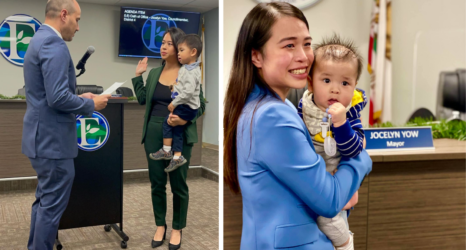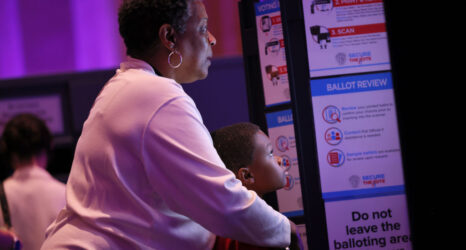With the 2018 election now in full swing, the Ms. Blog is excited to bring you content presented in conjunction with Gender Watch 2018, a project of the Barbara Lee Family Foundation and the Center for American Women and Politics. They’ll be tracking, analyzing and illuminating gender dynamics during election season—so check back with us regularly!
Much of the attention in the current election cycle has been on women. How many will run? How many will win? What’s motivating women voters? Will they turn out? But all of this is only half of the gender story of 2018. Men are navigating the gendered terrain of this election, too.
Men are the majority of candidates running in 2018; as of April 6, men made up 78 percent of filed candidates for the U.S. House. Women are not alone in increasing their candidacies this year—men, particularly Democratic men, are running in higher numbers as well. Even though the concentration of the candidate “surge” among Democrats in 2018 implies that some of the motivation to run this year is rooted more in partisanship than in gender, there is no denying that gender dynamics are at play.
In the era of #MeToo and women’s mobilization, it’s worth asking: Is misogyny is a motivator for men, too?
The responsibility for making lasting institutional and cultural change should not and can not fall solely on the shoulders of women. On the campaign trail, will men be asked how they take part in this reckoning? And how will they respond?
A new Pew poll shows that while men are far less likely than women to report being sexually harassed themselves, 58 percent of Democratic men identify “men getting away with sexual harassment/assault” as a major problem in U.S. workplaces. Will male candidates discuss how they will tackle that problem? Wisconsin House candidate Randy Bryce (D) provided an example in a March tweet touting the unionization of his campaign team as a way to ensure that “every worker feels safe in the workplace.”
Male candidates can cue their support for gender equality in other ways. In the Democratic primary for Kentucky’s 6th congressional district, Jim Gray put out an advertisement advocating for gender wage equity. Democratic nominee for governor in Illinois, Jay Pritzker, posted a campaign video celebrating the 2018 Women’s March titled “We Will Be Heard” that built on his October 2017 promise that he is “running as a proud feminist.”
These messages may also be emerging because of the surge in women candidates. Bryce and Gray are running against women—Cathy Myers and Amy McGrath, respectively—who have prioritized issues of gender equity in their primary bids, and previous research indicates that men competing against women might be more likely to address “women’s issues” than men running against men, at least when party is held constant as it is in primary races. In my book, I describe this as one of the compensation strategies employed by men in mixed-gender contests.
All of these examples also came from Democratic men. In a year when running against a woman is more likely for these men than in elections past, will we see that political calculations by male candidates yield increased attention to addressing gender equality and inclusion? Moreover, will it take having a female opponent for male candidates to address these issues, or will demand for change by voters—especially progressive women—elicit a response across a broader range of contests?
Not all men running for office see gender power imbalances as a problem, nor will all perceive attention to gender equality as important to their base of voters. One need to only look back to the 2016 presidential race for evidence—then-candidate Donald Trump was seemingly unaffected, or even buoyed, by attacks calling his rhetoric and behavior sexist. An October 2016 poll by the Public Religion Research Institute (PRRI) conducted after the release of the Access Hollywood tape found that 41 percent of Trump voters believed that “these days society seems to punish men just for acting like men.”
Even within this moment of heightened attention to sexism, there is no guarantee that male candidates will be more careful when it comes to their own behavior and rhetoric around women. Just last week, a male candidate competing against a woman for a state senate seat in North Carolina told voters at a candidate forum that the election “isn’t a beauty contest,” and said they shouldn’t pick a candidate “just because she’s pretty.” At a Pennsylvania forum for Democratic congressional candidates in March, a male candidate remarked that he didn’t think a woman could win the primary race in the 5th district—though he, of course, later clarified that he did not mean to imply his female opponent couldn’t win due to her gender. These instances serve as small but important reminders that the historic marginalization of women from American politics continues to shape the gendered terrain of campaigns today.
Will GOP candidates seek to tap that same sentiment in 2018, fueled by an even broader movement against (primarily) men’s bad behavior? That approach seemed far less successful in Roy Moore’s 2017 campaign for Alabama’s U.S. Senate seat than it did for Trump, but Missouri senate candidate Courtland Sykes (R) may have sought to appeal to the same type of voters when he waged his attack on feminism in January of this year.
The partisan differences in more general perceptions of and demands for gender equality may also shape how male candidates campaign this year. While voters across parties are likely to prioritize other, albeit related, issues—like economic security, national security or access to health care—in their vote choice this November, the data indicates that the national debates over and attention to gender disparities in wealth, power and well-being may influence both voters and candidates differently by party.
In a 2017 survey by PerryUndem, Republican men were the least likely to perceive gender inequality as a problem in the U.S.—39 percent of Republican men and 43 percent of men who voted for Trump said full equality has been achieved, compared to just 20 percent of all respondents. In contrast, 16 percent of Republican women reported that the work toward gender equality is done, whereas over 90 percent of Democratic women and 87 percent of Democratic men said they perceive gender equality as a work in progress.
Beyond the rhetoric they employ, the issues the emphasize or the approach they take to gender equity in 2018, male candidates’ strategic and tactical decisions in this year’s election—just like women’s choices—will either replicate or disrupt prevailing norms of gender in society and on the campaign trail. Whether they tout masculine credentials and use images that present them as manly men, as in this ad from Michigan gubernatorial candidate Jim Hines, or offer new models that do not rely upon playing the man card, such as that on display this video from Maryland gubernatorial candidate Rich Madeleno, male candidates play key roles in shaping the likelihood of stasis in or change to political institutions that have long been dominated by men.
Men are equal parts of the gender story of election 2018, and that is a story—in all of its nuance and complexity—that we need to tell.





